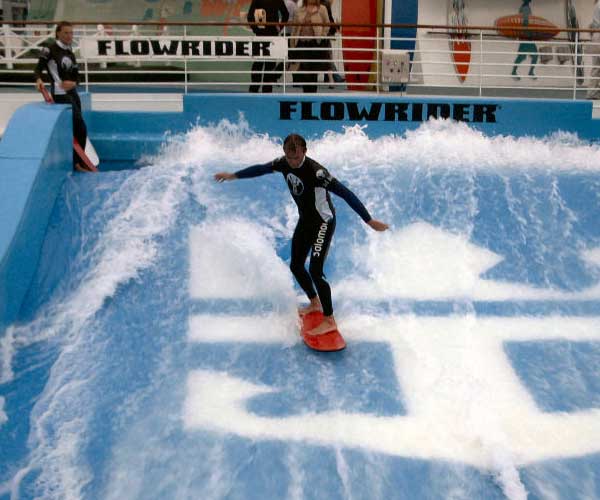Flowboarding
In flow-boarding, riders need to balance on an artificial wave, for which they use a combination of techniques and moves adapted from various board sports.
There are two ways of riding a wave – on a bodyboard and on a flow-board. Generally, beginners start off by learning bodyboarding wherein they attempt to ride the waves by balancing on the board with lying on their stomachs. The more advanced riders use a flow-board with which they ride the waves in a standing position.
It is highly a versatile sport for all ages that can meet the varying needs of each of its participants. From a kickflip to a rodeo flip, flow-boarding is quickly progressing to gain attraction around the globe.

FLOWRIDER RULES
- Obey the lifeguard at all times.
- Care must be taken to avoid an injury.
- Those who want to ride must be in good physical condition. Pregnant women and people with or having a history of heart, neck, back, shoulder or joint problems should not ride.
- Riders have to be at least 42 inches tall to bodyboard and at least 52 inches tall to Flow-board (stand-up).
- Permission of a parent/guardian is required for youth under the age of 18 to participate in the stand-up position Flow-rider
- Enter the ride only after receiving instruction from the lifeguard.
- Never jump into or enter the ride at high speed.
- Avoid putting weight on the front foot — You will be wiped out!
- You can shift your weight gently to control the board. Always keep your board pointed in the direction of the oncoming water flow.
- If you get wiped out, do not try to hold your board. Release board immediately, keep the limbs close to your body, cover your head, and try to brace for impact with your feet first.
- Multi-person riding is not allowed.
- The ride surfaces are very slippery. Do nottry to walk on it. You are allowed to walk on the dark blue drain grating to exit only after coming to a complete stop.
- Any kinds of stunts are not permitted.
BOARD DESIGN
Flow-riding has two different types of boards that a rider can choose from.
